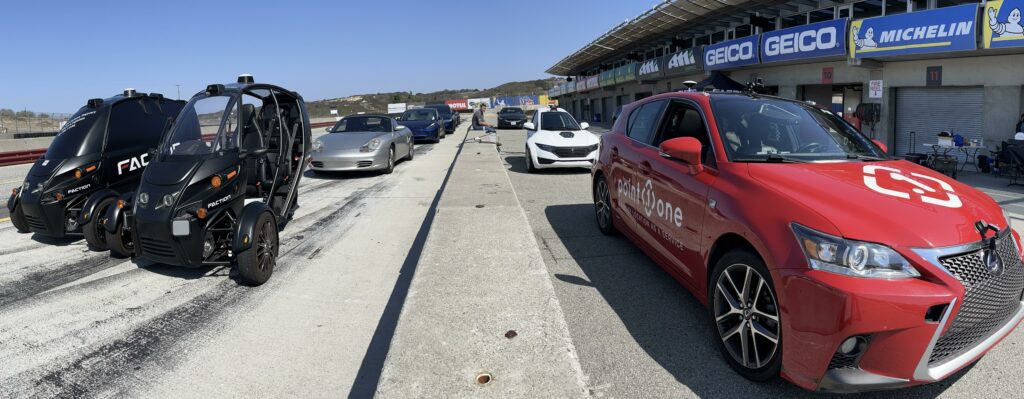Driverless delivery vehicles won’t go mainstream until they’re safe, reliable, inexpensive, and most importantly, profitable. Faction is developing the tech that will make autonomous last-mile fleets meet those demands and they’re working with Point One to do it.
In this case study we speak with Faction CEO Ain McKendrick about why they’re choosing Point One for GPS location services and the company’s plans for the future.
About Faction
Faction develops driverless vehicle systems for vehicle manufacturers. The Faction system uses a combination of computer-controlled autonomy and remote human (TeleAssist®) operators to create driverless last-mile curbside delivery and logistics fleets. The company works directly with OEM manufacturers to incorporate its autonomous systems into vehicles. The company was founded in 2020. Faction is currently testing its systems on small electric vehicles for last-mile deliveries within busy city centers and suburbs.

The Need for Speed
Faction found Point One on the racetrack. Both companies were testing autonomous driving hardware and software in the Self Racing Cars autonomous racing challenge at the Thunderhill racetrack in Willows, California.
“We showed up and the Point One car was circumnavigating Thunderhill, even driving it backwards,” said McKendrick. “We were there doing the same thing with some test vehicles using a combination of computer vision systems and GPS data. Both of our systems were designed to be lightweight, scalable, and cost effective—it seemed like a natural match and we decided to collaborate.”
Faction and Point One began working together to incorporate Atlas GPS positioning hardware into Faction test vehicles. Since then the two companies have been speeding into the future of autonomous delivery vehicles together.
Challenge: Making Autonomy Affordable
Creating true self-driving vehicles has been an industry challenge for nearly a decade. Most manufacturers use complex systems with LIDAR, radar, computer vision, and GPS to help their vehicles discern the world around them and navigate safely. These systems are often expensive and difficult to train. Faction wanted to deliver self-driving delivery vehicles to market quickly at an affordable price.
“We’re building a product and every partner that we look towards has to have something that is production minded and is going to be at the right price point to deliver on a production grade vehicle,” said McKendrick.
That means expensive, complex systems simply won’t do. Faction created a different model that incorporates computer vision with accurate GPS positioning and teleoperators. Vehicles using Faction technology will “see” using standard video cameras and navigate using precise real time GPS data. The challenge, however, was finding pinpoint GPS systems that were affordable and scalable.
“Some GPS systems can cost tens of thousands of dollars,” said McKendrick. “They deliver the accuracy we need, but at that price point we can’t integrate them into affordable driverless delivery vehicles. We needed something accurate, but affordable to deploy on a large scale.”
Solution: Point One Atlas
Faction started working to incorporate Point One Atlas into its driverless delivery system. Faction-equipped vehicles rely on Point One hardware and the Point One Real Time Kinematics (RTK) network. Faction cars and trucks communicate with fixed Point One RTK base stations to help remove common location errors. With Point One, Faction-equipped vehicles continuously receive precise location data to help them navigate. And because Point One utilizes inexpensive hardware and an easily expandable network, Faction can easily afford to deploy it in their systems.
“Point One is very comparable to some of the more expensive systems out there, but at a better price point with excellent accuracy and reliability,” said McKendrick. “That makes it a great solution for us because we’re committed to creating a turnkey product that’s appealing to manufacturers.”
The Point One system’s affordability means that Faction can incorporate other location systems into their autonomous driving scheme to improve accuracy even further. “Having a cost-effective solution like Point One that we can also marry with other systems so we can have comparable different implementations, and now we can cross check,” said McKendrick. “We are absolutely confident that the system knows where it is at any time.”
Faction has been able to integrate the Point One Atlas system into its vehicles in record time. “Point One has been a fantastic partner since the beginning. We’ve been able to move much quicker with Point One than some others in the space,” said McKendrick. “It’s a great example of startups collaborating with startups and moving at a startup pace.”
The Atlas Inertial Navigation System (INS) combines hardware with RTK and Sensor Fusion to seamlessly deliver location precision at a price that allows you to put them in every vehicle in your fleet. Atlas is the first scalable INS with real-time, cm-accurate position in x, y, z, and attitude. The system is perfect for autonomy, robotics, and mapping.
Atlas Structure:
Our corrections network measures common error sources to GNSS and transmits corrections straight to the Atlas. Pre-configured Atlas devices get Polaris free for 6 months.
Atlas UI
Simple plug and play setup with remote access configuration, control, and data logging. Easy to install and self-calibrating.
Fusion Engine
Best in class sensor fusion algorithms combine data from Atlas’ IMU, GNSS, Wheel odometry, and other sensors for highly accurate, highly available location.
Tech specs:
- Integrated UI and REST API control interface
- Multifrequency high-precision GNSS receiver
- Automotive grade (ASIL-B) IMU with 6 Axis Gyro/Accelerometer
- 64-bit Low-Power ARM Dual Processor Architecture
- Multi frequency GNSS antenna with mag-mount, RF and USB Cabling
- Configurable IO including PPS and event output
- No desktop software required. Ever.
- 100Hz Position Update Rate with 6DOF output over Ethernet
- CAN and wheel encoder vehicle odometry inputs
Ready to take your navigation systems to the next level? Start your free trial.
